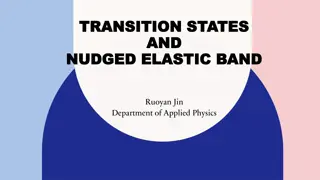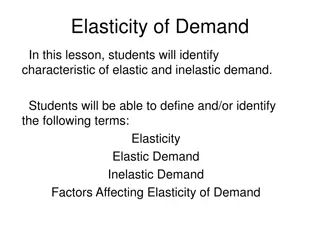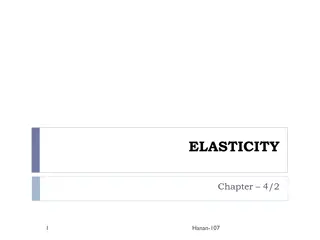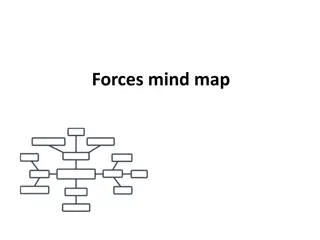Understanding Elastic Pendulum: Observing Changes in Spring Forces
In this activity, students analyze variations in the periodicity of the elastic force of a spring acting as a pendulum. The objective is to estimate approximate values for pendulum and elastic oscillation periods and establish a relation between them. The theory explains the behavior of oscillatory phenomena, the identification of oscillation periods, and the relation between spring stretch and compressive force. The impact of environmental factors on oscillation is also discussed, highlighting forced or damped oscillation.
Download Presentation

Please find below an Image/Link to download the presentation.
The content on the website is provided AS IS for your information and personal use only. It may not be sold, licensed, or shared on other websites without obtaining consent from the author. Download presentation by click this link. If you encounter any issues during the download, it is possible that the publisher has removed the file from their server.
E N D
Presentation Transcript
Elastic pendulum Observing changes in the elastic force exerted by a spring acting as a pendulum
Elastic pendulum Observing changes in the elastic force exerted by a spring acting as a pendulum Objective The objective of this activity is to observe and analyze variations in periodicity in the elastic force of a spring over a suspended mass, while maintaining a harmonic movement. From a qualitative analysis, students can estimate approximate values for the periods of pendulum and elastic oscillation, in addition to finding a relation between them.
Elastic pendulum Observing changes in the elastic force exerted by a spring acting as a pendulum Introduction and theory In nature, oscillatory phenomena are much more common than might be believed. The mechanics of gases and fluids, as well as the wave behavior of light and sound, are primarily studied as perturbations of some observable property in a certain system. Such is the case that some systems are able to present disturbances simultaneously in different directions and with different periodicities. What features does the movement of a pendulum present?
Elastic pendulum Observing changes in the elastic force exerted by a spring acting as a pendulum Introduction and theory How do you identify the beginning and end of a period of oscillation in the pendulum movement? What is the relation between the stretch of a spring and the force with which you try to compress to the initial length?
Elastic pendulum Observing changes in the elastic force exerted by a spring acting as a pendulum Introduction and theory Teor a A periodic motion in time with respect to a specific spatial direction has a similar graphic representation to a transverse wave. Thus, the change of a certain position of equilibrium has a maximum variation, as defined by the amplitude of the wave. The period of oscillation or the time that it takes the object to return to the same position, is proportional to the length of this wave.
Elastic pendulum Observing changes in the elastic force exerted by a spring acting as a pendulum Introduction and theory Every day we live in a saturated environment of matter, such as air. Therefore, it is expected that the amplitude of that oscillation decreases over time with each swing. This is due to the interaction of the object with the air and the energy dissipation this interaction causes. A movement of this kind is known as forced or damped oscillation , and can be represented graphically with the outline of a wave enclosed between two decreasing curves.
Elastic pendulum Observing changes in the elastic force exerted by a spring acting as a pendulum Introduction and theory In addition, some systems may have more than one oscillation in the same movement, presenting different periods. This is represented graphically as a wave enclosed inside a larger one. This type of movement is known as coupled oscillation . It is very useful in recognizing the different degrees of freedom that the system presents, by allowing it to oscillate about an equilibrium position.
Elastic pendulum Observing changes in the elastic force exerted by a spring acting as a pendulum Introduction and theory Now students are encouraged toraise a hypothesis which must be tested with an experiment. A mass is hang on a spring, as well as from a digital dynamometer, and the system of its position of equilibrium is shifted in order to obtain a pendulum motion. How will the elastic force of the spring vary? What graph would you expect to obtain for the force according to time?
Elastic pendulum Observing changes in the elastic force exerted by a spring acting as a pendulum Activity description Students will perform a continuous measurement of the spring force at one end of the spring. Meanwhile, at the other end, a mass of a pendulum will be allowed to oscillate, so that later the graphical representation of the spring force according to time can be observed and analyzed. Knowing the relation between the elastic force and the stretching of the spring, students can infer what kind of oscillation was present in the phenomenon. To do so, they must use the Dymo force and acceleration sensor.
Elastic pendulum Observing changes in the elastic force exerted by a spring acting as a pendulum Resources and materials Dymo force & acceleration USB cable 2 3 10 cm long spring 5 4 50 g mass Lab stand 4 5
Elastic pendulum Observing changes in the elastic force exerted by a spring acting as a pendulum Using the Dymo Configuring the Dymo To perform the measurements with the Dymo sensor, follow the instructions below: Open the GlobiLab program and turn on the Dymo. 1 Click the bluetooth icon on the lower right corner of the GlobiLab screen. Once the Dymo has been recognized by the program, the icon will change from gray to blue . If you prefer a USB connection, follow the instructions above by clicking the USB icon. You will see the same color change when the Dymo has been recognized . 2
Elastic pendulum Observing changes in the elastic force exerted by a spring acting as a pendulum Using the Dymo Click to set the Dymo. Select Force (5N) in the "Logger Setup window. Enter "10000 samples, 100Sec" for the sampling frequency. Once you have finished configuring the Dymo start the measurement by clicking . When you have finished measuring, stop the Dymo by clicking .
Elastic pendulum Observing changes in the elastic force exerted by a spring acting as a pendulum Experiment Arrange the components according to the figure. Move the pendulum from its equilibrium position and begin the measurement. Stop measurements after 20 seconds.
Elastic pendulum Observing changes in the elastic force exerted by a spring acting as a pendulum Results and analysis In each graph, indicate the points where the recognizable periods begin or end, by using the tool . Consider Hooke's Law to determine the proportionality of the vertical axis of the graph, with the direction in which the spring is stretched. Discuss the presence of different kinds of oscillation in the obtained graph, according to what is described in the introduction.
Elastic pendulum Observing changes in the elastic force exerted by a spring acting as a pendulum Results and analysis The graph below should be similar to the one the students came up with:
Elastic pendulum Observing changes in the elastic force exerted by a spring acting as a pendulum Results and analysis Observe the graph obtained after 20 seconds of measurement. What happens to the amplitude of each oscillation over time? How are the points that begin and end the oscillations identified? How many periods of oscillation are visible in the graph?
Elastic pendulum Observing changes in the elastic force exerted by a spring acting as a pendulum Conclusions Considering Hooke's Law; what relation emerges between the vertical axis of the graph and its shape? Students can determine from Hooke's Law, that the vertical axis of the graph corresponding to the spring force is also proportional to the stretching of the spring (Fe = -k x). Thus, the obtained graph corresponds to an oscillation about a point of equilibrium in the direction of the stretching of the spring. What features of the assembly are visible in the result? Students can identify two oscillation periods in the graph, as in the case of a coupled oscillation. They can recognize the cause of this as the overlap of the successive stretching and compression, together with the pendulum movement of the spring. Furthermore, they can recognize the damping of both as the amplitudes decrease, due to the presence of air around the system.
Elastic pendulum Observing changes in the elastic force exerted by a spring acting as a pendulum Conclusions + = ? NASA
Elastic pendulum Observing changes in the elastic force exerted by a spring acting as a pendulum Conclusions How is the period of oscillation of the spring as a pendulum determined? Students can identify a second wave and mark it with another color, joining and encircling the peak and valley points obtained in the wave chart. The period of oscillation of the spring as a pendulum corresponds to the minimum distance of three amplitudes. How is it possible to identify the damping of the system? Students can join the peaks of the wave that describe the period of oscillation of the spring as a pendulum, to determine a downward curve that wraps around the assembly waves.
Elastic pendulum Observing changes in the elastic force exerted by a spring acting as a pendulum Conclusions + = NASA























